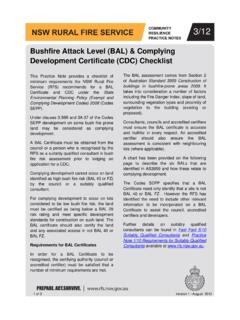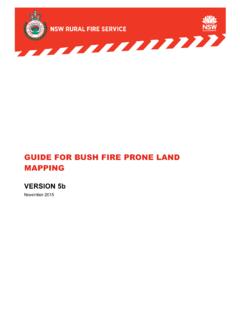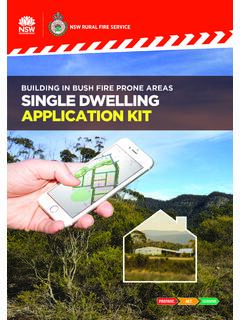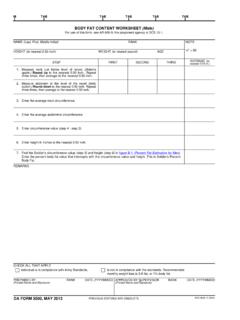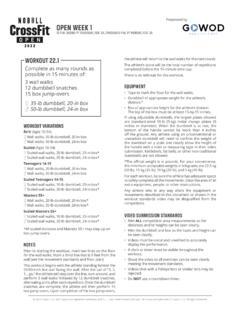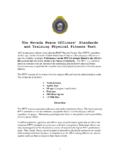Transcription of Standards for Asset Protection Zones - NSW RFS
1 Firewisefirewisefirewisefirewisefirewise firewisefirewisefirewisefirewisefirewise firewisefirewisefirewisefirewisefirewise firewisefirewisefirewisefirewisefirewise firewisefirewisefirewisefirewisefirewise firewisefirewisefirewisefirewisefirewise firewisefirewisefirewisefirewisefirewise firewisefirewisefirewisefirewisefirewise firewisefirewisefirewisefirewisefirewise firewisefirewisefirewisefirewisefirewise firewisefirewisefirewisefirewisefirewise firewisefirewisefirewisefirewisefirewise firewisefirewisefirewisefirewisefirewise firewisefirewisefirewisefirewisefirewise firewisefirewisefirewisefirewisefirewise firewisefirewisefirewisefirewisefirewise firewisefirewisefirewisefirewisefirewise firewiseprotection standardsfor Asset Protection zonesN S W R U R A L F I R E S E R V I C E2 Standards FOR Asset Protection ZONESINTRODUCTION.
2 3 WHAT IS AN Asset Protection ZONE? ..3 WHAT WILL THE APZ DO? ..3 WHERE SHOULD I PUT AN APZ? ..4 step 1. DETERMINE IF AN APZ IS REQUIRED ..4 step 2. DETERMINE WHAT APPROVALS ARE REQUIRED FOR CONSTRUCTING YOUR APZ ..5 step 3. DETERMINE Asset Protection ZONE WIDTH ..5 step 4. DETERMINE WHAT HAZARD REDUCTION METHOD IS REQUIRED TO REDUCE BUSH FIRE FUEL IN YOUR APZ ..6 step 5. TAKE MEASURES TO PREVENT SOIL EROSION ..9 step 6. ONGOING MANAGEMENT AND LANDSCAPING ..10 PLANTS FOR BUSH FIRE PRONE GARDENS ..10 WIND BREAKS ..113 INTRODUCTION For thousands of years bush fires have been a natural part of the Australian landscape. They are inevitable and essential, as many Australian plants and animals have adapted to fire as part of their life cycle. In recent years developments in bushland areas have increased the risk of bush fires harming people and their homes and property.
3 But landowners can significantly reduce the impact of bush fires on their property by identifying and minimising bush fire hazards. There are a number of ways to reduce the level of hazard to your property, but one of the most important is the creation and maintenance of an Asset Protection Zone (APZ). A well located and maintained APZ should be used in conjunction with other preparations such as good property maintenance, appropriate building materials and developing a family action IS AN Asset Protection ZONE? An Asset Protection Zone (APZ) is a fuel reduced area surrounding a built Asset or structure. This can include any residential building or major building such as farm and machinery sheds, or industrial, commercial or heritage buildings. An APZ provides: a buffer zone between a bush fire hazard and an Asset ; an area of reduced bush fire fuel that allows suppression of fire; an area from which backburning may be conducted; and an area which allows emergency services access and provides a relatively safe area for firefighters and home owners to defend their bush fire fuels should be minimised within an APZ.
4 This is so that the vegetation within the planned zone does not provide a path for the transfer of fire to the Asset either from the ground level or through the tree WILL THE APZ DO? An APZ, if designed correctly and maintained regularly, will reduce the risk of: direct flame contact on the Asset ; damage to the built Asset from intense radiant heat; and ember attack on the Asset . 4 WHERE SHOULD I PUT AN APZ?An APZ is located between an Asset and a bush fire hazard. The APZ should be located wholly within your land. You cannot undertake any clearing of vegetation on a neighbour s property, including National Park estate, Crown land or land under the management of your local council, unless you have written approval. If you believe that the land adjacent to your property is a bush fire hazard and should be part of an APZ, you can have the matter investigated by contacting the NSW Rural Fire Service (RFS).
5 There are six steps to creating and maintaining an APZ. These are:1. Determine if an APZ is required;2. Determine what approvals are required for constructing your APZ;3. Determine the APZ width required;4. Determine what hazard reduction method is required to reduce bush fire fuel in your APZ;5. Take measures to prevent soil erosion in your APZ; and6. Landscape and regularly monitor in your APZ for fuel 1. DETERMINE IF AN APZ IS REQUIREDR ecognising that a bush fire hazard exists is the first step in developing an APZ for your you have vegetation close to your Asset and you live in a bush fire prone or high risk area, you should consider creating and maintaining an , the more flammable and dense the vegetation, the greater the hazard will be. However, the hazard potential is also influenced by factors such as slope. A large area of continuous vegetation on sloping land may increase the potential bush fire hazard.
6 The amount of vegetation around a house will influence the intensity and severity of a bush fire. The higher the available fuel the more intense a fire will areas of vegetation are generally not a bush fire hazard, as they are not large enough to produce fire of an intensity that will threaten includes: bushland areas of less than one hectare that are isolated from large bushland areas; and narrow strips of vegetation along road and river you are not sure if there is a bush fire hazard in or around your property, contact your local NSW Rural Fire Service Fire Control Centre or your local council for advice. Dense vegetation(greater hazard)Sparse vegetation(lower hazard)5 step 2. DETERMINE WHAT APPROVALS ARE REQUIRED FOR CONSTRUCTING YOUR APZIf you intend to undertake bush fire hazard reduction works to create or maintain an APZ you must gain the written consent of the landowner.
7 Subdivided land or construction of a new dwellingIf you are constructing an APZ for a new dwelling you will need to comply with the requirements in Planning for Bushfire Protection . Any approvals required will have to be obtained as part of the Development Application process. Existing Asset If you wish to create or maintain an APZ for an existing structure you may need to obtain an environmental approval. The RFS offers a free environmental assessment and certificate issuing service for essential hazard reduction works. For more information see the RFS document Application Instructions for a Bush Fire Hazard Reduction Certificate or contact your local RFS Fire Control Centre to determine if you can use this approval in mind that all work undertaken must be consistent with any existing land management agreements ( a conservation agreement, or property vegetation plan) entered into by the property owner.
8 If your current development consent provides for an APZ, you do not need further approvals for works that are consistent with this you intend to burn off to reduce fuel levels on your property you may also need to obtain a Fire Permit through the RFS or NSW Fire Brigades. See the RFS document Before You Light That Fire for an explanation of when a permit is 3. DETERMINE THE APZ WIDTHThe size of the APZ required around your Asset depends on the nature of the Asset , the slope of the area, the type and structure of nearby vegetation and whether the vegetation is burn faster uphill than downhill, so the APZ will need to be larger if the hazard is downslope of the types of vegetation (for example, forests, rainforests, woodlands, grasslands) behave differently during a bush fire. For example, a forest with shrubby understorey is likely to result in a higher intensity fire than a woodland with a grassy understorey and would therefore require a greater APZ width.
9 A key benefit of an APZ is that it reduces radiant heat and the potential for direct flame contact on homes and other buildings. Residential dwellings require a wider APZ than sheds or stockyards because the dwelling is more likely to be used as a refuge during bush fire. Subdivided land or construction of a new dwellingIf you are constructing a new Asset , the principles of Planning for Bushfire Protection should be applied. Your Development Application approval will detail the exact APZ distance required. Existing assetIf you wish to create an APZ around an existing Asset and you require environmental approval, the Bush Fire Environmental Assessment Code provides a streamlined assessment process. Your Bush Fire Hazard Reduction Certificate (or alternate environmental approval) will specify the maximum APZ width allowed. For further information on APZ widths see Planning for Bushfire Protection or the Bush Fire Environmental Assessment Code (available on the RFS website), or contact your local RFS Fire Control 4.
10 DETERMINE WHAT HAZARD REDUCTION METHOD IS REQUIRED TO REDUCE BUSH FIRE FUEL IN YOUR APZThe intensity of bush fires can be greatly reduced where there is little to no available fuel for burning. In order to control bush fire fuels you can reduce, remove or change the state of the fuel through several means. Reduction of fuel does not require removal of all vegetation, which would cause environmental damage. Also, trees and plants can provide you with some bush fire Protection from strong winds, intense heat and flying embers (by filtering embers) and changing wind patterns. Some ground cover is also needed to prevent soil can be controlled by:1. raking or manual removal of fine fuels Ground fuels such as fallen leaves, twigs (less than 6 mm in diameter) and bark should be removed on a regular basis. This is fuel that burns quickly and increases the intensity of a fuels can be removed by hand or with tools such as rakes, hoes and shovels.



